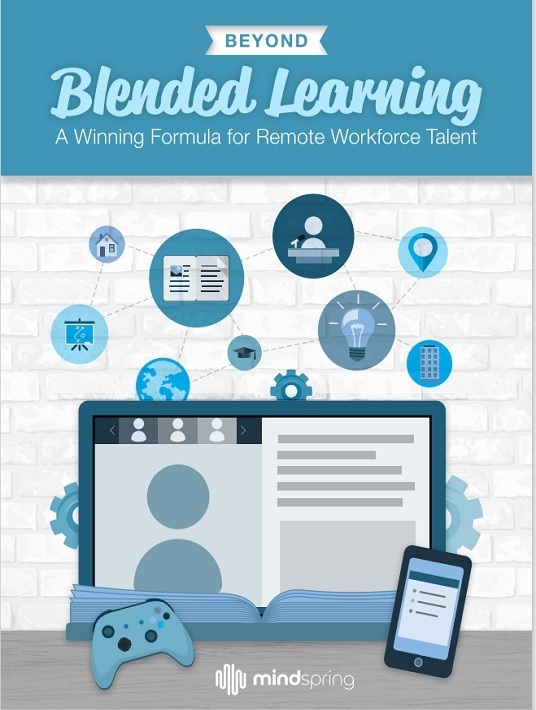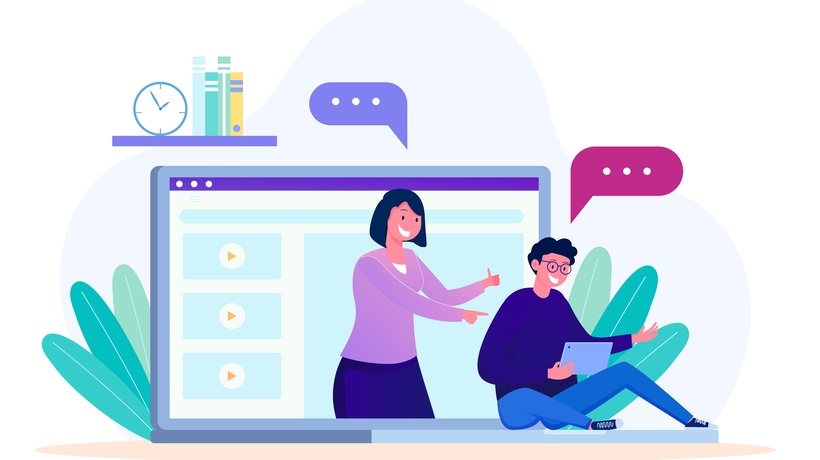What's The Best Blended Learning Program For Your Organization?
This article is part of a series exploring the concept of blended learning for remote and on-site workers. What you are about to read is a fable. The company, AshCom, is fictional but the learning challenges faced by Kathryn, AshCom’s CLO, and her team are real and commonly shared by learning teams in large organizations. It is our hope that you will be able to connect with the characters, their challenges, and the solutions they discover. We also invite you to read the first eBook in the series.

Overnight Planning Sessions
The AshCom nine-member learning team did not often do overnight planning sessions. The Ash family, founders of AshCom, had a cottage less than an hour from the company’s headquarters that was made available for small gatherings. The word “cottage” did not do it justice. It was a huge home with manicured lawns and gardens including a small vineyard, something not typically found in Minneapolis. The setting was perfect for a few days away from the office to think about thorny problems related to the future of the company.
Kathryn, the Chief Learning Officer of AshCom, took advantage of the offer of the cottage but only when she and her team were facing a particularly perplexing problem. This was that moment. They faced two complex challenges that were having a significant impact on the company.
The first was what everyone had taken to calling “the skills gap.” While certainly a part of it, retirements were increasing as people of a certain age group were leaving. But that wasn’t the whole story. At the same time, they, like many of their competitors in manufacturing, we’re struggling to attract new talent. In the midst of this dynamic, the technical skills required for smart manufacturing were increasing with the expanding use of robotics and automation.
The second challenge was related to the first, at least in terms of attracting new people and keeping the people they had. Human Resources was reporting that requests for more flexible schedules or even being completely remote were rising among possible candidates and current employees. The HR team tasked Kathryn and her team to figure out how learning opportunities might be delivered with a more remote office workforce.
The Best Blended Learning Program Formula
Darryl, one of Kathryn’s team members, and Rebecca, from Inno-Versity, proposed they think through these challenges using a formula:
N1+N2+T+D=M
In the morning session, Kathryn broke her team into two groups. Group A was assigned to focus on N1 and N2 – the needs of AshCom and the needs of the learners for both issues. This team included Maggie, Amy, Darryl, and Adeena. All were experienced instructional designers but referred to themselves as “learning experience designers.”
The second group was tasked with creating a list of all the tools available to the AshCom learning team in doing their work. This team was made up of Alishia, Michael, Martina, and Rebecca. Alishia and Martina were learning experience designers. Michael was a retired university professor who helped Kathryn think through difficult issues. Rebecca worked for Inno-Versity but had become a trusted part of Kathryn’s team. She was current on technology and learning science and her perspectives were invaluable.
Kathryn asked both teams to complete their work just before lunch and then report their findings while they ate. When the group reassembled, Kathryn had food ready.
As they took their food and their seats, Kathryn said, “Needs Team, are you ready to present what you discussed? Who is going to present while everyone else eats?”
Team A all looked at Darryl. “I’ve been elected. Probably not because I am the best person to report but because everyone else was hungry.”
Maggie, a member of Team A, gave a thumbs-up as she took a bite of her salmon wrap.
50,000-Foot Thinking
Darryl continued, “Because we spent a lot of time talking about the needs of AshCom last night and earlier this morning, we felt like we had that pretty clear in our heads. The need of AshCom is to have highly skilled and knowledgeable people in every role in our company of over 7,000 people. We all agreed that this need never really goes away. Some people retire. Some new people join our team. But the overall need for AshCom remains. People are everything.”
Kathryn liked this answer. It was good 50,000-foot thinking. She replied, “Maybe this needs to stay at the top of every needs list we ever do?”
Amy was still eating her salad but chimed in, “I’ve not seen this in other companies where I consult, but that would be a really good idea.”
“Ok,” said Kathryn, “but you know I need you to apply this to our current challenges. What does this mean in the context of a growing skills gap and people wanting to work remotely?”
“That’s where I was going next,” said Darryl. “Since our part is learning, let’s focus on that. We would like to spend some time with retiring team members. Not just exit interviews. HR does that. We mean someone on our team spending an hour with retiring technicians. What was working for them? What did they think of our learning experiences? What new skills have they needed to develop in the last couple of years? What does the increase of automation and technology mean for them in the context of their work?”
“Trying to capture some institutional knowledge before retiring people walk out the door,” said Kathryn. “I like that. What else?”
“We talked about the possibility of some of these retiring people continuing in a very limited capacity as coaches or mentors for new people,” said Darryl. “AshCom needs to get new people up to speed as quickly as possible and they might listen more closely to experienced people.”
“Very practical,” said Kathryn. “Anything else?”
“We already discussed some of the learning needs of AshCom that will come if HR decides to open more positions to remote work. We feel confident that we can meet a lot of these needs with the learning experiences we’ve already created via mobile, games, etc. Our recommendation would be to randomly look at a few dozen modules and decide how well they would work for people working remotely. Some will work fine. Some would need minor revisions. Others might need major revisions. At least we could start putting learning experiences in these three buckets.”
Addressing Learners' Needs
“What about the needs of the learners? That was the second part of your assignment,” said Kathryn.
“Two hours isn’t enough time to answer completely,” said Darryl, “but we thought a lot about younger people joining our manufacturing team. Automation and
robotics are interesting to them. These things might have been unsettling to some of the people who are planning to retire soon, but we don’t think that’s the case
with younger people. They live their lives in technology. Chances are, many of them have already been deeply involved in digital learning.”
Michael, who was part of Team B and older than everyone else, said “I completely agree. High school and college education are very different from what they used to be. It is more hands-on and more digital at the same time. One of my sons went through a tech program in high school. The technology was incredible. He was more likely to be working on a robot than with a monkey wrench.”
“So, the needs of the learners will be met with more hands-on experiences but that doesn’t necessarily mean standing next to someone who shows them step by step how to maintain a machine?” asked Kathryn.
“Exactly,” said Darryl. “We haven’t done much with augmented reality or virtual reality. But we could. Our team is saying we should if we want to meet AshCom’s
need for highly skilled people in every single position.”
By now, more people had finished eating. Adeena, part of Team A, said, “I wonder what it would do to our ability to attract new people if they knew that our learning program was incredibly cool and would end with them understanding the best of manufacturing technology? Our team thinks it would make a big difference.”
Kathryn thought for a moment. “So, if I am hearing you correctly, you want to go ‘old school’ and have retiring people coach newer ones while also giving the new team members the most high-tech training we can think of?”
“We didn’t put it exactly that way,” said Darryl, “but that’s a good summary of what we came up with.”
“One more thing,” said Kathryn. “Before we broke into two groups, Maggie asked which takes precedent, the needs of the company or the needs of the learners. How did you answer that?”
Maggie smiled. “We decided that in great companies, this is a false dichotomy. We don’t think there is a situation in which the needs of AshCom and the needs of
the learners are at odds. They are notes being played at the same time. They might be separate questions, but they must be considered together. If we want AshCom to truly be a world-class company where everyone thrives, we need to hold the needs of the company and the needs of learners together. Separating these is a serious mistake.”
Kathryn smiled. “I truly love that answer. I hope we never lose sight of this!”
Everyone nodded.
“Let’s take 15 minutes to clean up and get comfortable. Then we can learn what Team B discussed about tools. Will that work for everyone?”
Both teams agreed. They were off to a good start.
Conclusion
Download the eBook Beyond Blended Learning: A Winning Formula For Remote Workforce Talent to discover how AshCom overcomes its L&D challenges using innovative blended learning strategies. Also, join the webinar to uncover valuable insights that will help you improve your L&D planning and learning delivery.








